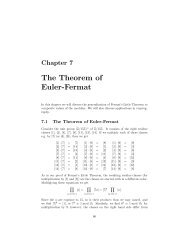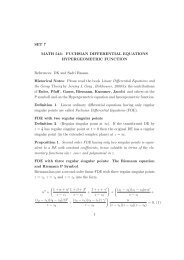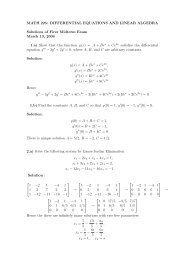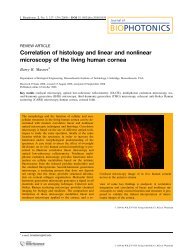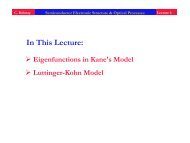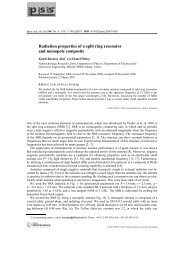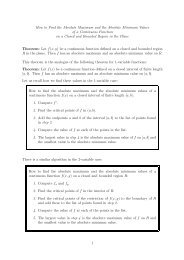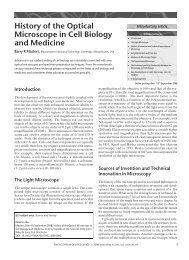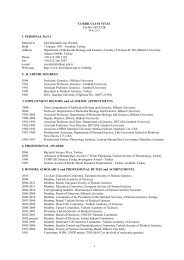Introduction to the English Edition of Hilbert's Zahlbericht
Introduction to the English Edition of Hilbert's Zahlbericht
Introduction to the English Edition of Hilbert's Zahlbericht
Create successful ePaper yourself
Turn your PDF publications into a flip-book with our unique Google optimized e-Paper software.
<strong>the</strong> first inequality k has odd class number h. Thus ±q h is <strong>the</strong> norm <strong>of</strong> an integer from k,<br />
and considering this equation as a congruence modulo p yields (±q h /p) = +1; but since<br />
(−1/p) = +1 and h is odd, this implies (q/p) = +1.<br />
Kummer’s line <strong>of</strong> attack was similar (<strong>the</strong> basic idea in both pro<strong>of</strong>s is <strong>the</strong> observation<br />
that norms are norm residues modulo ramified primes), but he soon found 25 that <strong>the</strong> first<br />
inequality would not suffice for a pro<strong>of</strong>. In fact, Kummer’s as well as Hilbert’s first pro<strong>of</strong><br />
(see §160 <strong>of</strong> <strong>the</strong> <strong>Zahlbericht</strong>) both use that <strong>the</strong> number <strong>of</strong> genera in certain extensions is<br />
exactly ℓ. The three main differences <strong>of</strong> <strong>the</strong> pro<strong>of</strong>s are:<br />
1. Kummer’s pro<strong>of</strong> uses <strong>the</strong> first supplementary law, which he had derived earlier using<br />
cyclo<strong>to</strong>my, 26 whereas Hilbert can do without it.<br />
2. Kummer works in a certain subring <strong>of</strong> <strong>the</strong> ring <strong>of</strong> integers OK <strong>of</strong> <strong>the</strong> Kummer<br />
extensions K; Hilbert transfers <strong>the</strong> whole <strong>the</strong>ory <strong>to</strong> OK.<br />
3. Although Kummer occasionally derived necessary conditions for an integer in k <strong>to</strong><br />
be a norm from K, <strong>the</strong> <strong>the</strong>ory <strong>of</strong> <strong>the</strong> norm residue symbol is a genuine achievement<br />
<strong>of</strong> Hilbert, and it is here that he goes beyond Kummer: see e.g. Satz 167, which is<br />
a special case <strong>of</strong> Hasse’s norm <strong>the</strong>orem.<br />
4 A few Noteworthy Details<br />
Let us now look more closely at a few places where Hilbert’s treatment in <strong>the</strong> <strong>Zahlbericht</strong><br />
differs from what one is used <strong>to</strong> <strong>to</strong>day. The first such instance occurs when Hilbert proves<br />
<strong>the</strong> unique fac<strong>to</strong>rization <strong>of</strong> ideals in<strong>to</strong> prime ideals in <strong>the</strong> ring <strong>of</strong> integers <strong>of</strong> an algebraic<br />
number field via Leopold Kronecker’s <strong>the</strong>ory <strong>of</strong> forms and Dedekind’s so-called “Prague<br />
Theorem”—see §§5–6. 27 Hilbert does, however, also point out alternative pro<strong>of</strong>s <strong>of</strong> this<br />
key result, at <strong>the</strong> end <strong>of</strong> §6.<br />
Since we are <strong>to</strong>day looking back on <strong>the</strong> <strong>Zahlbericht</strong> from a distance <strong>of</strong> 100 years,<br />
a few pro<strong>of</strong>s <strong>the</strong>re strike us as somewhat roundabout. For instance, in <strong>the</strong> pro<strong>of</strong> that<br />
precisely <strong>the</strong> prime divisors <strong>of</strong> <strong>the</strong> discriminant are ramified as well as in his discussion<br />
<strong>of</strong> <strong>the</strong> splitting <strong>of</strong> primes, in particular <strong>of</strong> those dividing <strong>the</strong> discriminant <strong>of</strong> a generating<br />
polynomial (see §§10–13 <strong>of</strong> <strong>the</strong> <strong>Zahlbericht</strong>), Hilbert switches again from Dedekind’s ideal<strong>the</strong>oretic<br />
language <strong>to</strong> Kronecker’s <strong>the</strong>ory <strong>of</strong> forms. Modern pro<strong>of</strong>s built upon Hensel’s<br />
p-adic <strong>the</strong>ory may be more appealing.<br />
25 “Wegen dieses Umstandes reicht auch der gefundene Satz, daß die Anzahl der wirklichen Genera<br />
nicht größer ist, als der λte Teil der möglichen, nicht aus, sondern es ist nöthig, daß die Anzahl der<br />
wirklichen Genera genau gefunden werde, wozu andere Prinzipien erforderlich sind, als welche Gauß zur<br />
Ergründung dieser wichtigen Frage für die quadratischen Formen angewendet hat.” [ Über die allgemeinen<br />
Reciprocitätsgesetze der Potenzreste, Collected Papers I, 673–687, in particular p. 682].<br />
26 “und zwar unter einem erheblichen Aufwande von Rechnung”, as Hilbert remarks in §161.<br />
27For <strong>the</strong> background <strong>of</strong> this argument, see H.M. Edwards, The Genesis <strong>of</strong> Ideal Theory, Archive Hist.<br />
Exact Sciences 23 (1980), 321–378; here in particular: section 13, pp. 364–368.<br />
8



